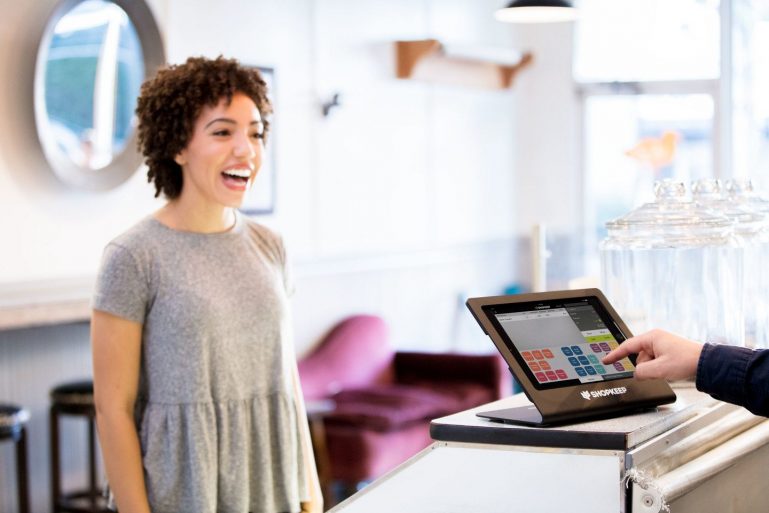
The Great Debate: Cash Register vs. POS
Whether you’re a new business owner or looking to make improvements to an existing business, one area you simply can’t ignore is the technology you use to ring up customers and process sales.
Maybe you bought an existing business and inherited a legacy POS terminal, or you’re about to open your first store and are leaning towards a traditional electronic cash register. Whatever your situation, it literally pays to ask, “Am I using the best system to process sales for my business?”
This article will help you answer that question and potentially identify a new tool you want to add to your business operations. We’ll give you an overview of the features and costs associated with each system, as well as criteria to guide your decision-making process. Let’s get started.
Cash Register Overview
The electronic cash register is the traditional workhorse of the retail, quick-service restaurant (QSR), and full-service restaurant (FSR) industries. I think we’ve all seen a cash register before, so I’m not going to describe one in great detail. It’s a basic tool that gives sbusinesses the ability to ring up sales, calculate tax, store receipts and cash in a cash drawer, and print out simple end-of-day reports for balancing the register and performing rudimentary sales tracking.
Depending on how advanced (read: expensive) the register, you may be able to use additional hardware like a credit card reader and barcode scanner alongside the register. Some cash registers even include small digital displays to improve the accuracy of transactions, and allow customers to see the transaction details.
Basic cash registers are priced around $100, with more sophisticated registers coming in at $300 – $400. Additional hardware like credit card and debit card readers, barcode scanners, and scales must be purchased separately.
Point of Sale System Overview
Point of sale (POS) systems offers all of the functionality of a cash register, along with advanced features that allow businesses to operate more effectively and efficiently. It’s important to note that POS systems fall into two broad categories: traditional POS systems and newer mobile point of sale (mPOS) systems.
Traditional POS systems have been around for decades. You usually see these in full-service restaurants and bars, or in big-box retail stores. They typically run on a combination of proprietary and nonproprietary hardware, which often includes:
- A touchscreen device for entering sales
- A desktop computer running where the POS software actually runs
- A computer server for storing sales data
- Any additional payment hardware you choose like credit card readers and barcode scanners
Traditional POS systems can run anywhere for $1,500 to $5,000 per terminal for both hardware and software.
There are significant differences between mPOS systems and traditional POS systems. First, they run on an iPad or Android tablet versus a PC or other proprietary hardware. Additionally, the vast majority are cloud-based, so there’s no need for a server. Your data will be accessible anywhere you have an internet connection.
Lastly, mPOS systems are typically sold on a software-as-a-service (SaaS) model. This means that the business pays a monthly subscription fee for using the software instead of purchasing it outright.
Why Use a Cash Register?
Despite the clear advantages offered by modern POS systems, there are some reasons why a business might want to go with a traditional cash register.
Affordability: While newer mPOS systems are more affordable than traditional POS systems, it’s hard to beat the price of a conventional cash register. For right around $100, a small business has pretty much everything they need to begin processing cash transactions. Of course, if you want to take credit card and/or smartphone payments like Apple Pay, you’ll need to purchase additional hardware.
Long Lifespan: The cash register was invented in 1879. The fact that the device remains in use today is a testament to its longevity. Cash registers are basic devices with few moving parts. While this limits what they can do, it makes them last a long time. This is an advantage when compared to traditional POS systems that require you to pay extra for software updates and customer support. However, as we’ll cover below, cash registers don’t have this advantage over most mPOS systems. Since they’re typically SaaS products, their subscription fee includes access to all future versions of the software and customer support. This allows an mPOS to evolve with your business through a continuously improving POS experience.
SEE ALSO: Small Business Basics: What is POS Software?
Why Choose a POS System
There’s something to be said for the spartan reliability of a traditional cash register, but that just doesn’t compare to the potentially transformative power of a POS system. Here’s what we mean.
Smarter Inventory Management: POS systems automate inventory management. When a customer buys from you, the system automatically updates your inventory count so you know when you need to reorder, versus having to perform inventory tracking manually.
Better Decision Making: POS systems give businesses advanced analytics and reports to guide their decision making. These reports can cover everything from sales by hour to inventory performance at the item level. Compared to a traditional cash register, the amount of insight that a POS system delivers can seem a revelation.
Software Integrations: POS systems typically integrate with popular pieces of software like accounting and marketing systems, sharing data between them. This allows you to run your business more intelligently and efficiently. For example, pushing daily sales data directly into your accounting system, can result in time savings and prevent accounting errors. This isn’t possible with a cash register.
Simplified Staff Management: Most POS systems allow employees to clock-in right from the system, eliminating the need to buy a dedicated time clock. Furthermore, you can usually run reports on each employee’s sales performance, allowing you to make smart decisions about staffing and training programs.
Targeted Customer Marketing: Point of sale systems make it easy to collect customer email addresses at the point of purchase. This allows you to build your subscriber list for use in email marketing campaigns. Some systems associate purchases with a customer email address, allowing you to better target customers with email marketing.
Why Use an mPOS
If by this point you’ve decided that a POS system is the right choice for your business, the question then becomes, “mPOS or traditional POS?” Let’s dig in.
I’m just going to come right out and say it, for most small businesses, choosing an mPOS makes the most sense. Traditional POS systems have two significant drawbacks: high costs and subpar usability.
As we noted above, traditional point of sale systems are expensive. But that’s only half of the equation. You will likely incur other charges over the lifetime of the system. For example, if you want customer support, most traditional POS systems will require you to purchase a support package which will typically cost several hundred dollars. The alternative is to pay per incident. Per incident support is typically priced either as a flat fee or you could end up paying per hour of support time used.
Traditional POS systems usually run on proprietary hardware. This means that when something breaks you need to go back to the vendor and pay to have repairs made or buy an entirely new piece of equipment. Since this hardware is proprietary and not “off the shelf,” it’s typically more expensive than its generic equivalent.
The last cost to consider is the price of software upgrades. When the POS vendor releases an updated version with new features, you don’t automatically get access to it. Instead, you need to buy a new license for the updated version. Depending on how significant the upgrade is, this can be very expensive.
Outside of cost, usability is often another issue with traditional POS systems. These systems are old. They have outdated interfaces that are confusing and overly complex. This can lead to significant efficiency problems. Until your team learns the system, things, like ringing up customers and splitting guest checks, are just going to take longer. Not only is this annoying for your employees, but it can really irritate customers.
Most mPOS systems don’t have these problems. Since they’re sold as a SaaS product, you’ll pay a reasonable monthly subscription fee to access the software. This fee will typically include access to at least basic customer support at no extra charge. You’ll also get access to all future versions of the software for free. Updating an mPOS is as simple as visiting the iTunes App Store or Google Play and hitting update just like an app on your phone. In a few minutes, you’re good to go with the latest and greatest point of sale software.
SEE ALSO: Cash Registers: The Ultimate Crutch for Small Businesses
The hardware tends to be better too. Because these systems run on iPads or Android tablets, and work with standardized credit card readers and receipt printers, it’s much easier and more affordable to repair or get new hardware if needed.
Lastly, mPOS systems tend to be newer and more modern. They’ve learned from the mistakes of a traditional point of sale systems. As a result, they typically feature sleek, user-friendly interfaces, that help your team get up to speed far faster than other tools. Key functionality like integrating other tools with your POS, or checking analytics reports also tends to be easier to do.
Whether you choose a cash register, POS, or mPOS it’s going to be a central part of your business, so it’s a decision to be carefully considered. Making the wrong choice can cost you valuable time and money. To help you, we put together a free guide, Choosing a POS System, which walks you through the process from start to finish. You can get your copy by clicking the button below.
Want to try ShopKeep for yourself?
Just answer a few easy questions.
Need help finding the right point of sale?
Just complete the form. We’ll call you right back to explain how ShopKeep can work for you.
Hit the ground running.Sprinting, in fact!
Read our free, comprehensive guide, Small Business 101, to learn all you need to know about starting a thriving business.

